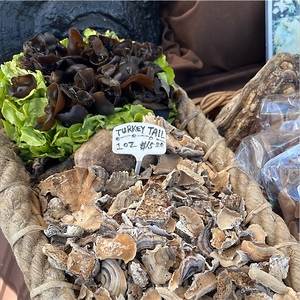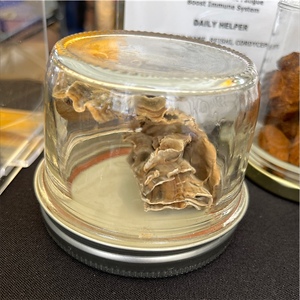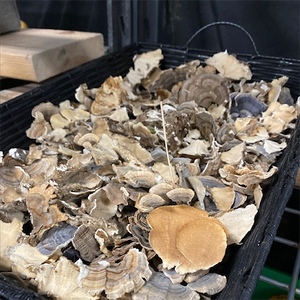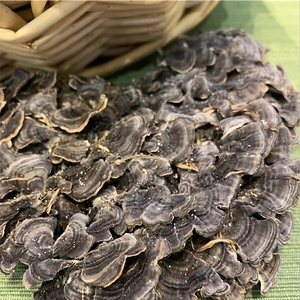


Turkey Tail Mushrooms
Estimated Inventory, lb : 0
Description/Taste
Turkey Tail mushrooms are flat with a kidney to disc-like shape, averaging 2 to 8 centimeters in diameter, and can be found growing in compact, overlapping layers and rows. The cap of the mushroom is very thin, smooth, pliable, and velvety, covered in tight, concentric rings varying in hues of yellow, brown, red, orange, ivory, and grey. The edges of the cap can be flat or wavy, and below the cap, tiny pores sheath the cream-colored underside that holds thousands of white spores. Turkey Tail mushrooms have a leathery, tough texture, creating a chewy consistency, and have a mild, earthy flavor.
Seasons/Availability
Turkey Tail mushrooms are available year-round, with a peak season in the fall through winter in the northern hemisphere.
Current Facts
Turkey Tail mushrooms, botanically classified as Trametes versicolor, are multicolored, striped fungi that belong to the Polyporaceae family. Growing on decomposing logs, stumps, branches, and pieces of hardwood, Turkey Tail mushrooms are one of the most common varieties of fungi found in woodland forests worldwide. Turkey Tail mushrooms earn their name from their similarity in appearance to a turkey’s multicolored tail and have been used for centuries as a medicinal mushroom by traditional herbalists. It is important to note that this bracket fungus has many lookalike varieties in the wild and some foragers will sell many of these mushrooms under the Turkey Tail name.
Nutritional Value
Turkey Tail mushrooms contain vitamins B3 and D, which can help boost the immune system, and provide prebiotics that can help increase digestion. The mushrooms also contain antioxidants such as flavonoids and phenols that are known to have anti-inflammatory properties.
Applications
Turkey Tail mushrooms are not commonly consumed fresh as their chewy, leathery texture is often regarded as unpalatable. The mushrooms are popularly dehydrated or dried for use in teas and are ground into a powder with other mushrooms as a medicinal supplement. When used as a tea, the mushrooms are simmered in boiling water for an extended period to extract essential nutrients. Once brewed, the tea contains a semi-bitter, earthy flavor and can be balanced with honey or other teas such as reishi or green tea. The extracted concoction can also be used to cook curries, stews, and soups or used to flavor vegetables and rice. Dehydrated Turkey Tail mushrooms will keep up to two years when stored in a sealed container in a cool, dry, and dark place.
Ethnic/Cultural Info
In traditional Chinese medicine, Turkey Tail mushrooms are used to boost the immune system and promote overall wellness within the body. Known as Yun Zhi and believed by many Chinese herbalists to look like swirling clouds, Turkey Tail mushrooms have been brewed in teas and medicinal drinks for thousands of years in China and are consumed daily to promote long life, health, and strength. Turkey Tail mushrooms are also believed to help increase energy and fight inflammation in the digestive tract.
Geography/History
Turkey Tail mushrooms are native to woodland forests around the world and have been growing wild since ancient times. Recorded in medicinal texts as early as the 15th century in China, the mushrooms are still foraged from the wild today and are cultivated on a small scale for medicinal uses. Turkey Tail mushrooms can be found wild, at health food stores, specialty grocers, and sold through online retailers in powder or capsule form in Asia, Europe, and North America.
Recipe Ideas
Recipes that include Turkey Tail Mushrooms. One











